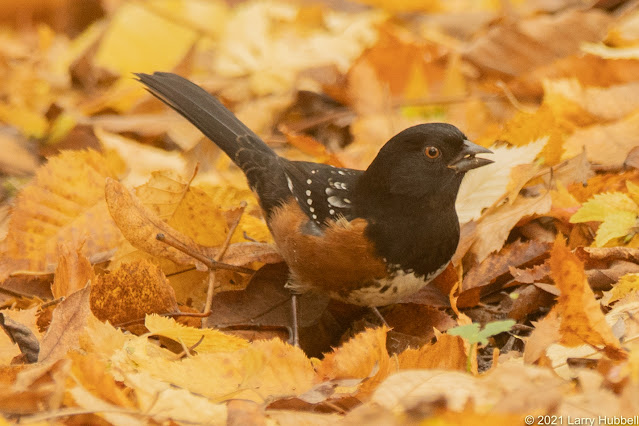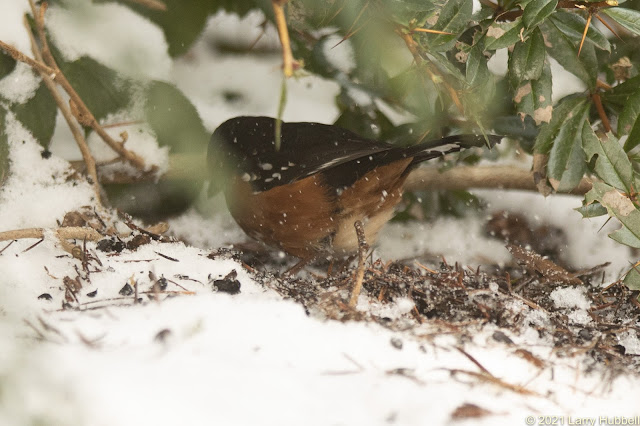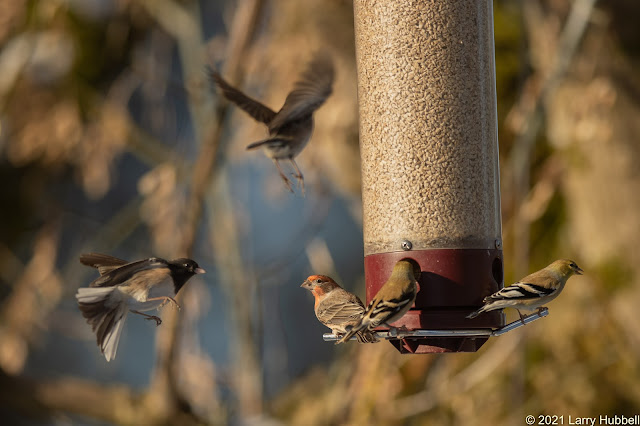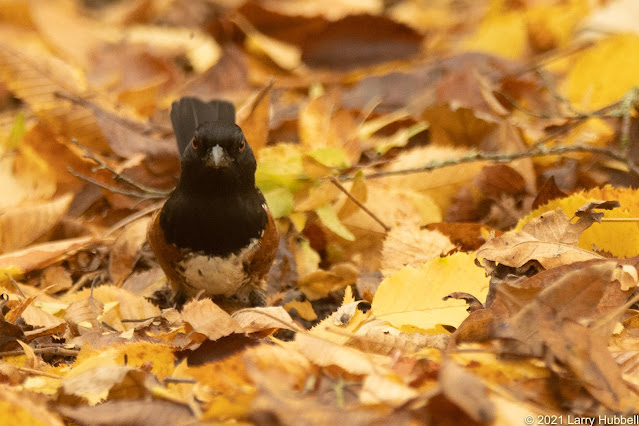The Winter Garden in the Arboretum - December 2021.
Snow can be beautiful. However, it can be hard on life, including humans, birds, and trees. During the current cold snap, I became interested in observing how our resident birds adapted.
Around noon on New Year's Eve, 2021, Monty was sitting near their newly rebuilt nest. Both he and the nest seemed indifferent to the cold.
During the winter, the local Bald Eagles often eat American Coots. The number of Coots on Union Bay typically increases during the coldest months, so even when the fish descend to lower levels (while trying to escape the cold) Monty and Marsha have an alternate source of food.
Being at the top of the food chain results in meals that are generally faster to find and consume than fruits, nuts, seeds, or insects. However, their "extra" time is not totally free. They have a fairly large territory which they watch and defend from younger, unmated Eagles who want to poach on their food supply.
However, as long as they have an adequate supply of food, the snow does not seem to have much impact on the Bald Eagles. Follow this link to see a different example of Bald Eagles thriving in the snow:
On the other hand, Dark-eyed Juncos typically spend a lot of their time on the ground searching for fallen food, like seeds, while grabbing any insects they come across. (As we saw in the last post, they will occasionally eat fruit.) However, when the snow covers the ground most of their food supply is hidden.
Also, being much smaller than Bald Eagles their heat loss situation is more challenging, see Bergmann's Rule. To retain more heat this bird has partially raised the feathers covering its lower body. This allows it to trap more insulating air and maximizes its heat retention.
Earlier this week, I watched a Dark-eyed Junco take flight from beneath this Spruce tree. The tree's dense branches helped to create a lighter than average "dusting" of snow on the ground below. The Junco took advantage of this opportunity to find food. The circuitous tracks provide proof of its intense search.
This partially obscured Spotted Towhee apparently found a piece of fruit that was quickly consumed.
If you look closely you can see that the Towhee has also expanded its feathers to try to retain heat. In particular, notice how the shape of its body resembles a ball. Geometrically, a perfect sphere exposes the minimum surface area for the maximum volume. No doubt this is part of its heat retention strategy.
Soon, the Towhee flew to a spot under a different bush, where the ground was partially exposed. It seemed obvious that the Towhee intentionally selected this site. The disturbed area was unlike the heavily snow-covered ground below other nearby bushes.
In the Fall, Towhees thrive in leaf litter. They raise their tails and use both feet in a jumping/scratching motion that throws the leaves behind them.
The decomposing leaves provide heat and food to a variety of lifeforms, while also covering fallen food like seeds. Their excavating behavior gives them access to these food sources.
By the way, the term "leaf litter" is a misnomer. It makes leaves seem like trash or waste, which implies they should be removed to keep everything clean and tidy. Actually, fallen leaves are a tree's method of returning valuable nutrients to the soil, so they can be reused in a sustainable cycle. The real waste occurs when we spend energy removing the leaves, breaking the cycle, and downgrading the habitat for both the tree and the birds.
It is interesting to note that a Towhee's body does not look like a ball during warmer weather.
In the Winter Garden, the Towhee used the same excavating process to remove the snow.
Since snow is not as easy to grasp as leaves no doubt the effort was more challenging. However, the result was the same. The Towhee found food.
If you happen to be walking through the Winter Garden, and see a partially cleared area like this, you might step away and watch to see if the Towhee returns.
On Christmas Day, I came across a Red-breasted Nuthatch scampering around the side of a Western Red Cedar. If you zoom in you might just be able to see that it was carrying something. It did not stop to eat. My assumption was that it was looking for an appropriate crevice in the tree's bark to store the food. Most likely, the forward-thinking Nuthatch has had an adequate supply of cached food to consume during the cold snap.
Plus, since Red-breasted Nuthatches excavate and nest in tree cavities, I wonder if they might roost in the cavities during cold weather. I have seen other cavity-nesting birds using old nests during Winter.
In January of 2020, I watched Anna's Hummingbirds feeding among the Mahonia blossoms during a cold snap. Curiously, this year the blossoms came almost a month earlier. The last time I checked, the blossoms were declining and there were no hummingbirds to be seen at the Mahonias in the Winter Garden.
Human encroachment on the environment, like parking lots, buildings, mowed grass, the removal of "leaf litter" and dead trees, provides birds with fewer options for food and protection during cold weather.
Bird feeders are one way to offset some of the food lost. My neighbors, Della and Bruce, provide the largest, most well-attended feeder I have seen.
This week, in addition to the American Goldfinches and a House Finch, a Dark-eyed Junco wanted to get in on the feast.
However, they all gave way when the larger Red-winged Blackbirds joined the party.
I am sure my neighbors would want me to mention that bird feeders come with the responsibility to ensure they are kept clean. To learn why cleanliness is so important Click Here.
At noon on Christmas, I stopped by Duck Bay. The Canada Geese were abnormally quiet and inactive. They were not feeding. They were not sounding their normal alarm at seeing a human or a dog. They were not squabbling or mating. They were not even paddling in circles like Northern Shovelers. I do not remember ever seeing them so quiet or so still. It seemed obvious they were waiting for something.
Curiously, this happened just before the snow began to fall at the beginning of our current cold snap. I cannot prove that this odd behavior was related to the coming snow and cold, or even explain how or why, but the timing sure makes me wonder.
In this post, I focused mostly on year-round resident birds. It is worth mentioning that migration is probably the most widely used avian strategy for dealing with the cold. (Migration is like a chain with many links. The failure of a single link can make a chain useless.) With climate change and human development, it is difficult to predict our impact on migrating birds, but it is certainly worth studying. Click Here to read about one such effort.
Have a great day on Union Bay...where nature lives in the city and Black Birders are welcome!
Sincerely,
Larry
Going Native:
Each of us, who breathe the air and drink the local water, needs to watch and protect our local environment. Native plants and trees encourage the largest diversity of lifeforms because of their long intertwined history with our local environment and native creatures. I have been told that even the microbes in the soil are native to each local landscape. I hope we can inspire ourselves, our neighbors, and local businesses to respect native flora and to support native wildlife at every opportunity. I have learned that our most logical approach to native trees and plants (in order of priority) should be to:
1) Learn and leave established native flora undisturbed.2) Remove invasive species and then wait to see if native plants begin to grow without assistance. (When native plants start on their own, then these plants or trees are likely the most appropriate flora for the habitat.)3) Scatter seeds from nearby native plants in a similar habitat.4) If you feel you must add a new plant then select a native plant while considering how the plant fits with the specific habitat and understanding the plant's logical place in the normal succession of native plants.
Click Here to access a King County publication that explains the best placement for a wide variety of native plants. It looks extremely helpful.
Also, my friend Tom Brown pointed out that the application named 'Wildflower Search' is very helpful. Click on the highlighted link to see for yourself.
Also, Jane Lundin has created a small package, with a lot of critical information that looks quite handy, and light, for backpacking in the mountains in Springtime. It is titled, Mountain Wildflowers of Washington.)
Another idea that integrates perfectly with living in harmony with nature is the concept of Forest Gardening. Native Americans collected and nurtured dense multi-layered gardens of native herbs, plants, shrubs, and trees that produced food and herbal medicines. Even after 150 years of no maintenance, the gardens are essentially intact and the diversity of life remains significantly higher than in the surrounding forests. Click Here to learn more.
**************
In the area below it is my intention to display at least one photo each week to help challenge us to know the difference between native and non-native lifeforms.
Scroll down for the answer.
****************
Snowberry: Click Here to learn more.
*****************
The Email Challenge:
In response, I have set up my own email list. With each post, I will manually send out an announcement. If you would like to be added to my personal email list please send me an email requesting to be added. Something like:
Larry, I want to see more of nature. Please add me to your personal email list.
Thank you for your patience and interest!
Another common issue is losing your input while attempting to leave a comment on this blog. Often everything functions fine, however, sometimes people are unable to make it past the robot-detection challenge or maybe it is the lack of a Google account. I am uncertain about the precise issue. Sadly, a person can lose their comment with no recovery recourse.
My email address is:
LDHubbell@comcast.net
*******************
The Comment Challenge:
Bottom Line:
If you write a long comment, please, copy it before hitting enter. Then, if the comment function fails to record your information, you can send the comment directly to me using email.
My email address is:
LDHubbell@comcast.net
Sincerely,
Larry
*******************
Final Photo:
























I have been a landscaper for over 20 years. I always used to be obsessive about cleaning up the beds until I took notice of the birds in the area. Now, I leave a area in every bed for the birds to use through the winter. It's so fun to watch who comes throughout the winter to eat and find some shelter. Luckily, my clients enjoy this as well! Thanks for all you do Larry!
ReplyDeleteThank you, It is wonderful to hear how you are having an ongoing positive impact on the local ecosystem! After reading E.O. Wilson’s book “Half Earth” I wondered if we could convince homeowners to plant the front yard for show and the backyard as habitat. If all yards in a neighborhood were planted that way the backyards would connect (from a wildlife perspective - in spite of fences) and create neighborhood sanctuaries. Just a thought. Thanks again.
DeleteThank you, It is wonderful to hear how you are having an ongoing positive impact on the local ecosystem! After reading E.O. Wilson’s book “Half Earth” I wondered if we could convince homeowners to plant the front yard for show and the backyard as habitat. If all yards in a neighborhood were planted that way the backyards would connect (from a wildlife perspective - in spite of fences) and create neighborhood sanctuaries. Just a thought. Thanks again.
ReplyDelete